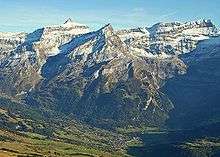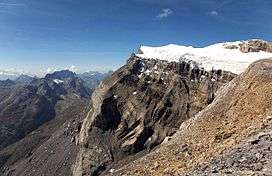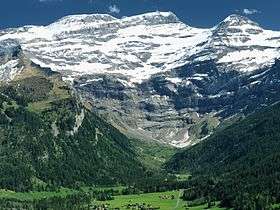Diablerets
| Diablerets | |
|---|---|
| Les Diablerets | |
|
The 2,000-metre-high north side of the Diablerets | |
| Highest point | |
| Peak | Sommet des Diablerets |
| Elevation | 3,210 m (10,530 ft) |
| Prominence | 968 m (3,176 ft) [1] |
| Isolation | 14.3 km (8.9 mi) [2] |
| Parent peak | Finsteraarhorn |
| Listing | Canton high point |
| Coordinates | 46°18′14″N 7°11′21″E / 46.30389°N 7.18917°ECoordinates: 46°18′14″N 7°11′21″E / 46.30389°N 7.18917°E |
| Naming | |
| Translation | The Abode of Devils (French) |
| Geography | |
 Diablerets Location in Switzerland | |
| Country | Switzerland |
| Cantons | Vaud, Valais and Bern |
| Parent range | Bernese Alps |
| Topo map | Swiss Federal Office of Topography swisstopo |
| Geology | |
| Mountain type | Limestone |
The Diablerets (French: Les Diablerets; lit. "the abode of devils")[3] are a huge ice-covered mountain massif of the Alps, culminating at the Sommet des Diablerets (VD, VS) at 3,210 metres (10,530 ft) above sea level and straddling the border between the Swiss cantons of Vaud (VD) and Valais (VS). The northeastern part of the massif streches also into the canton of Bern (BE).
The Diablerets massif, which consists of several peaks, extends for about 10 kilometres near the western extremity of the Bernese Alps, between the two deep passes, the Cheville Pass (2,038 m (6,686 ft)) right below the main summit to the south, and the Sanetsch/Sénin Pass (2,252 m (7,388 ft)) to the east. The mountain is covered by two distinct glaciers, the largest being the Tsanfleuron Glacier and the highest being the Diablerets Glacier.
Worth mentioning are the Culan (VD, 2,789 m (9,150 ft)) at the western end of the massif, the Tête d'Enfer (VD, 2,762 m (9,062 ft)) right south of it, the Tête Ronde (VD, 3,037 m (9,964 ft)) just 800 metres west of the main summit, Le Dôme (VS, 2,986 m (9,797 ft)) between the two glaciers, the distinctive Tour St-Martin (VS, 2,908 m (9,541 ft)) also called Quille du Diable, where one also finds the Refuge l'Espace, east from the Dome, the Sex Rouge (VD, 2,971 m (9,747 ft)) with the top cable car station to the north, the Oldehore/Becca d'Audon (VD, BE, VS; 3,123 m (10,246 ft)) east of it, and the Sentschore/Mont Brun (BE, VS; 2,924 m (9,593 ft)) further to the northeast. North of it, right above Gsteig are to be found the Schluchhore (BE, VS; 2,579 m (8,461 ft)) and the Mittaghore (BE, 2,334 m (7,657 ft)).
The Oldehore is the meeting point of all three cantons, and several peaks have a German as well as a French name. Very impressive is also the formerly glaciated lower two thirds of the Tsanfleuron Glacier, west from the Sanetsch pass and east of the still existing glacier, called Lapis de Tsanfleuron, an area of about 8 square kilometres (3.1 sq mi).
The main summit (officially referred to as Sommet des Diablerets) is the highest point in the canton of Vaud. In the latter canton, the mountain has given its name to the nearby village and resort of Les Diablerets, which lies on the north side of the massif. On the south side (Valais) the mountain overlooks the hamlet and valley of Derborence.
Administratively, le Sommet des Diablerets is shared between the municipalities of Conthey (VS), Ormont-Dessus and Bex (VD).
Description


Along with the Muverans, the Wildhorn and the Wildstrubel, the Diablerets are one of the four distinct and glaciated massifs of the Bernese Alps that lie between the Rhone elbow and the Gemmi Pass. The main section of the mountain, between the cantons of Vaud and Valais, is part of the Rhone basin, through the rivers Grande Eau (north) and Lizerne (south). The easternmost part of the massif, that lies in the canton of Bern, is part of the Rhine basin, though the river Saane. The tripoint between the three aforementioned cantons is the Oldenhorn. The two largest glaciers (Tsanfleuron and Diablerets) are both on the Valais side. They form a single inclined plane towards the east, although they are separated by the rocky summit of Le Dôme (2,986 m). They are not very steep, especially the Tsanfleuron Glacier, as the rock strata are close to horizontal. The smaller and higher Diablerets Glacier, however, is much wilder than the Tsanfleuron Glacier as it is steeper and more crevassed. The Tsanfleuron plateau, between Le Dôme and the Sanetsch Pass is only partly glaciated. Below 2,600 m is a large karst zone.
Outside the highest summit, the main peaks are the Culan, the Tête Ronde, the Scex Rouge, the Oldenhorn and the Sanetschhorn. Also notable is the tower-like peak of the Quille du Diable ("devil's skittle") that overlooks Derborence from the edge of the Tsanfleuron plateau.
Along with the Culan, the Tête Ronde, and the Scex Rouge, the main summit forms an amphitheatre of limestone cliffs with numerous water falls, surrounding the valley of Creux de Champ and overlooking Les Diablerets from a height of over 2,000 metres. The height of the north wall is about 1,600 metres, its bottom (named Rochers de Champ) lying at 1,600 metres.
As for the other mountains on the crest of the Bernese Alps, the slopes of the Diablerets experience different types of climate depending on their location:[4] the northern slopes are cooler and wetter while the southern slopes are dryer and warmer. Forests are found up to 1,900 metres on the north side and up to 2,000 metres on the south side. Further south in Valais, on the slopes of Mont Gond, vineyards are also very common below 1000 metres, but completely absent on the north side. There, alpine pastures dominate the landscape, as in many other areas of the northern Alpine foothills.
Tourism and climbing
Since 1964, an aerial tramway connects the Scex Rouge from the Col du Pillon, 4 kilometres east of the village of Les Diablerets. The Tsanfleuron Glacier, easily accessible from the Scex Rouge mountain station, has then become part of a large ski area with several ski lifts on it, culminating at nearly 3,000 metres. The area is also popular in summer for the snow hikes on the glacier. The summits of Le Dôme and Oldenhorn can be reached in a few hours from the station.
The main summit, although not very distant from the Scex Rouge station, can not be easily reached as it involves the crossing of the much-crevassed Diablerets Glacier.
See also
- List of mountains of Vaud
- List of mountains of Valais
- List of mountains of Switzerland
- List of most isolated mountains of Switzerland
References
- ↑ Retrieved from the Swisstopo topographic maps. The key col is the Sanetsch Pass (2,242 m).
- ↑ Retrieved from Google Earth. The nearest point of higher elevation is southwest of the Wildhorn.
- ↑ Beattie, Andrew (2006). The Alps: A Cultural History. Oxford University Press. p. 109. Retrieved 2014-11-13.
- ↑ This results in different colors of the vegetation, which can be seen on satellite images such as those available on Google Earth (2015 imagery)
External links
![]() Media related to Les Diablerets (massif) at Wikimedia Commons
Media related to Les Diablerets (massif) at Wikimedia Commons
- Diablerets on summitpost
- Diablerets on Hikr
- Official web site of the ski resort (available in French, English and German)
- Official web site of the Glacier 3000 ski region (available in French, English and German )
